DIACLEAR INGREDIENTS
This guide is a general-health document for adults 18 or over. Its aim is strictly educational. It does not constitute medical advice.
This guide is based on scientific studies, but individual results do vary. If you engage in any activity or take any product mentioned herein, you do so of your own free will, and you knowingly and voluntarily accept the risks. While we mention major known interactions, it is possible for any supplement to interact with other supplements, with foods and pharmaceuticals, and with particular health conditions. Please consult your doctor for advice.
This Supplement can lower your blood sugar. When taken in combination with each other or drugs known to lower blood sugar (i.e., antidiabetic drugs). they might have additive effects and could cause a hypoglycemic event (i.e., very low blood sugar). For these reasons, take the following precautions. Prior to beginning a combo, speak with your healthcare provider about your intention to begin taking supplements that can affect blood sugar, as adjustments to current medications or treatments may be needed.
Drawing from all we’ve learned, we’ve designed DiaClear based on the scientific evidence
Insulin (a hormone produced in your pancreas) rises when blood glucose [1] rises; it lowers blood glucose by telling various cells to absorb it (for storage in your liver or muscles, or for immediate use) and your liver to stop producing it.[2]
The ability of cells to absorb glucose in response to insulin is called insulin sensitivity, and low insulin sensitivity is called insulin resistance — the more sensitive, the less resistant, and vice versa. It is also possible for you to produce too little insulin, if you have type 1 diabetes or are in the late stages of type 2 diabetes, in which case you suffer from insulin deficiency. In either case, glucose can’t be removed efficiently from your blood, causing hyperglycemia (overly high glucose levels).[3]
Hyperglycemia causes oxidative stress and inflammation and impairs several physiological processes,[4][5][6] thereby damaging your body and increasing the risk of many diseases — cardiovascular diseases, mostly,[7] but probably also cancer, Alzheimer’s, and Parkinson’s.[8][9][10]
Insulin resistance paves the road to type 2 diabetes, which accounts for 90% to 95% of all diabetes cases and has become a global health issue. In 2016, the World Health Organization (WHO) estimated that the percentage of diabetics in the world population had nearly doubled since the 1980s, for a total of 422 million diabetics. However, while the incidence keeps increasing in some countries, on a worldwide scale it seems to have either leveled off or decreased since the early 2000s.[11]
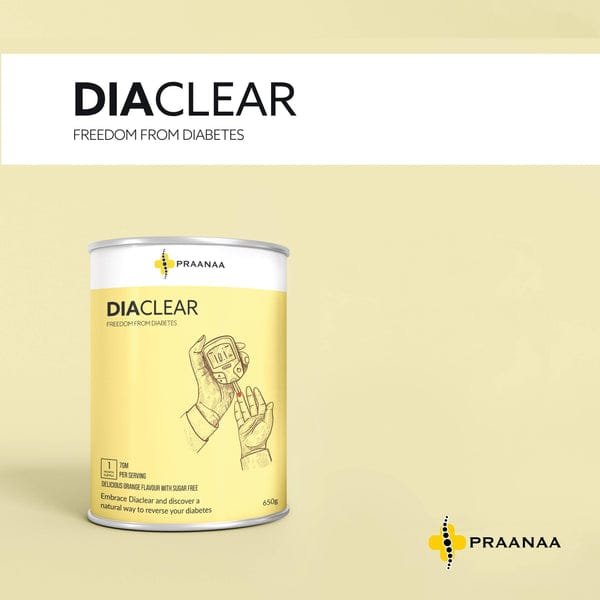
In 2017, the Centers for Disease Control and Prevention (CDC) reported an important, steady increase in the rate of diabetes in the US over the past 60 years, with 30.3 million Americans (nearly 1 in 10) having diabetes and 84.1 million American adults (approximately 1 in 3) having prediabetes [12] (which is to say, blood glucose levels high enough to be harmful and lead to diabetes[13]).
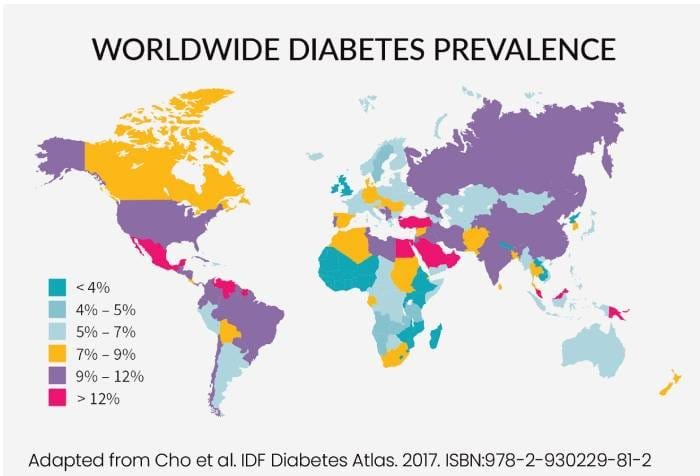
The major cause of type 2 diabetes is excess caloric intake and the resulting obesity. Unsurprisingly, weight loss can help. One review found that weight loss from all kinds of interventions — surgery, appetite-suppressing medicines, lifestyle interventions, or a combination — alleviates diabetes.[14]
Surprisingly, many long-term studies that used only a diet to achieve weight loss reported only modest improvements in diabetes. Why? Probably because few achieved substantiallong-term weight loss.[15] Moreover, exercise in itself can help reduce the risk and severity of type 2 diabetes. [16][17][18]
Measuring blood glucose
Glycemic control can be tested in several ways, each with its own cutoff values indicating impaired glucose regulation.[19] Of these tests, fasting blood glucose is the most common, followed by HbA1c.
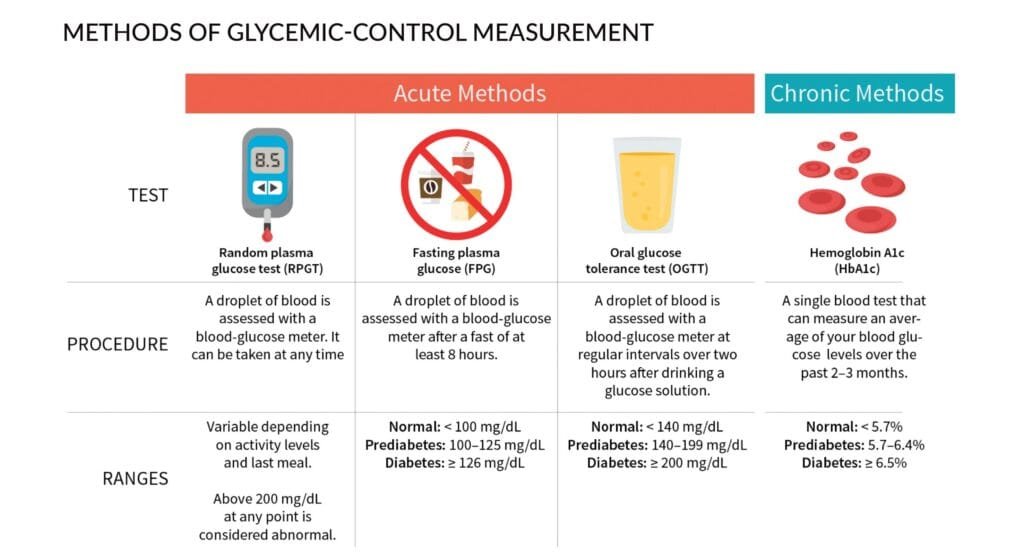
- Fasting blood glucose levels canvary from day to day, and so a single test may not be entirely reliable.[20][21]
CORE INGREDIENTS
Diaclear has the best safety-efficiency profile. When used responsibly, they are the supplements most likely to help and not cause side effects.
Fiber from Husk of Plantago ovata
Fiber can improve blood sugar controlin healthy and diabetic individuals. It may also reduce the risk of developing type 2 diabetes.
Fiber is a category of carbohydrates resistant to digestion that pass through our small intestine to be excreted or fermented in the large intestine by microbes. Fiber helps slow down the absorption of carbohydrates, which explains why it — notably the soluble type — has a favorable effect on blood sugar regulation.
Soluble fiber dissolves in your stomach into a gel that slows down the digestion of food. This gel also helps lower blood sugar by delaying and reducing carbohydrate absorption in the body.[22] Soluble fibers may also increase insulin sensitivity, possibly due in part to the short-chain fatty acids born from their fermentation by the gut microbiome.[23]
Insoluble fiber does not dissolve in your stomach but gently “scrubs” your digestive tract. It speeds up the rate at which food moves through your intestinal tract, yet it may also increase insulin sensitivity and bind to potentially harmful chemicals, such as carcinogens, allowing them to be excreted.[22][23][24]
How fiber may benefit insulin sensitivity
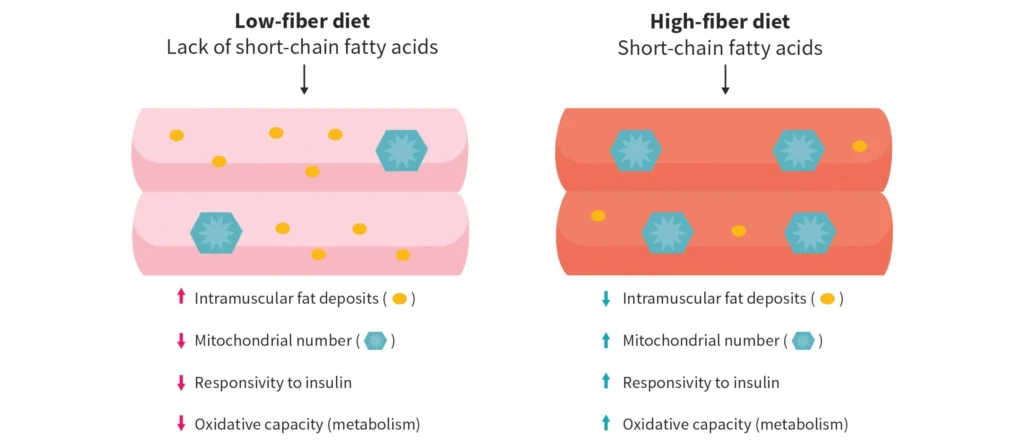
Adapted from McNabney and Henagan. Nutrients. 2017.[25]
Soluble fibers with a higher viscosity have shown the greatest and most consistent results at improving blood sugar control, the most studied types being psyllium, guar gum, and beta-glucan.[26][27][28][29][30][31] Viscosity refers to the fiber’s ability to form a gel-like substance when mixed with fluids.[32]
A high-fiber diet has not only been shown to improve blood glucose control, especially in people with type 2 diabetes, but also been consistently associated with a decreased risk of type 2 diabetes.[34][35] Thus, fiber can help people with normal blood sugar maintain or modestly improve their blood glucose control while decreasing their type 2 diabetes risk.
It’s important to note that the vast majority of studies showing a reduction in type 2 diabetes risk from fiber intake were in people who consumed fiber primarily from food sources (i.e., people with lower diabetes risk tended to have a higher overall intake of vegetables, whole grains, fruits, legumes, etc.).[34]
MORE INFORMATION ABOUT FIBER
To date, no Tolerable Upper Intake Level(UL) has been set for fiber.[33][36]
While not inherently low in fiber, very low calorie, low-carbohydrate, and ketogenic diets can sometimes be lower in fiber than other diets due to a reduction in plant matter intake.[37][38][39]
Supplemental fiber may interfere with the absorption ofdigoxin(Digox, Lanoxin Pediatric, Digitek), [40] carbamazepine(Tegretol XR, Equetro, Epitol),[41]levothyroxine(Synthroid, Tirosint, Unithroid),[40] andlithium.[40] Do not take fiber within at least 30 minutes of taking these medications. It’s possible that supplemental fiber may interfere with other medications not listed above. Out of caution, it may be prudent to separate pharmaceutical intake from fiber by at least 30 minutes as well. (This can also apply to other supplements).
Fiber supplements are not known to cause low blood sugar (i.e., hypoglycemic events), but it is theoretically possible — though not probable — when taken with other supplements or pharmaceuticals that can lower blood sugar, such as most antidiabetic drugs.
RESULTS
In people with impaired blood glucose control, taking ≈10–15 g/day of a supplemental soluble viscous fiber over at least 8 weeks has been shown to provide the following benefits:
- HbA1c reduction of−88 to−0.28%
- People with an HbA1c of ≥9.15% may see a −54 to−0.51% reduction.
- Fasting blood glucose reduction of−32 to−0.31 mmol/L (−23.78 to−5.59 mg/dL)
- People with a fasting blood glucose of ≥75 mmol/L (≥175 mg/dL) may see a−2.05 to−0.43 mmol/L (−36.94 to−7.75 mg/dL) reduction.
- Fasting insulin reduction of−97 to +0.60 pmol/L (−2.73 to +0.09 mIU/L)
- HOMA-IR (a measure ofinsulin sensitivity) reduction of−45 to−0.33
Our supplement DiaClear gives 15 g/day of Fiber. It is preferred for its high viscosity, which can aid in blood sugar regulation, and low degree of fermentation, which makes it less likely to produce unwanted side effects. In studies of soluble viscous fibers, it has also produced greater favorable effects on blood glucose control.[28]
Berberine
Caution: An important disclaimer
Much of the research on berberine is available only in Chinese, so this section relies heavily on English-language review papers and meta-analyses covering these studies. While we are able to assess the methodology of the reviews and meta-analyses, we are unable to directly evaluate some of the individual papers included in them. Therefore, we have given extra caution to berberine’s classification and dosages in this guide.
What makes berberine a primary option
Berberine can improve blood sugar control, HbA1c, and insulin sensitivity, particularly in those with type 2 diabetes.
Berberine is an alkaloid compound extracted from various plants, such as Berberis aquifolium, Berberis aristata, and Argemone mexicana. It can lower blood sugar levels by activating enzymes that draw blood glucose into cells and signaling that glucose should be used for energy production.[42]
Most berberine trials looking at blood glucose control have lasted 3 months, with a few trials lasting longer (four RCTs were ≥6 months).
In six placebo-controlled trials conducted in China, berberine lead to a large reduction in blood sugar levels and HbA1c in patients with type 2 diabetes.[43] It may do the same and improve insulin sensitivity in people who are not type 2 diabetic but have impaired blood glucose control or insulin resistance.[44][45][46] Additionally, extracts and juices derived from the berberine-containing barberry fruit showed similar results (i.e., reduced blood sugar and HbA1c, improved insulin sensitivity) in people with type 2 diabetes. [47][48][49][50]
Further research has compared berberine to antidiabetic drugs and compared berberine + antidiabetic drugs to the drug alone. This research suggests that using berberine along with either of the diabetes drugs metformin or gliclazide is more effective than berberine or the drugs are separately. Some results indicated that berberine may be just as effective as some pharmaceuticals, such as metformin, gliclazide, and glyburide.[43]
While low blood sugar (i.e., hypoglycemic events) has not been readily observed in clinical trials, no long-term trials tracked this outcome. It is possible berberine may cause low blood sugar, so some caution is warranted, particularly when taken with supplements or pharmaceuticals that can lower blood sugar.[51]
People with type 2 diabetes who are notcurrently taking pharmaceuticals for their condition may see a reduction in fasting blood sugar between−1.37 and−0.67 mmol/L (−24.68 to−12.07 mg/dL) and a reduction in HbA1C of−0.90 to−0.44%.
People with type 2 diabetes who arecurrently taking pharmaceuticals for their condition may see a reduction in fasting blood sugar between−1.03 and−0.47 mmol/L (−18.56 to−8.47 mg/dL) and a reduction in HbA1C of−1.29 to−0.05%.
In people who have signs of prediabetes, berberine supplementation may lead to reductions in blood sugar, HbA1c, and insulin resistance.
In the case of those taking glipizide, adding berberine may only lead to a small improvement. With those taking metformin, the addition of berberine appears to lead to moderate improvement.[43]
Magnesium
WHAT MAKES MAGNESIUM A PRIMARY OPTION
Magnesium may help improve insulin sensitivity, especially in people with type 2 diabetes or prediabetes who have low magnesium levels.
ROLE OF MAGNESIUM IN DIABETES AND CARDIOVASCULAR DISEASE
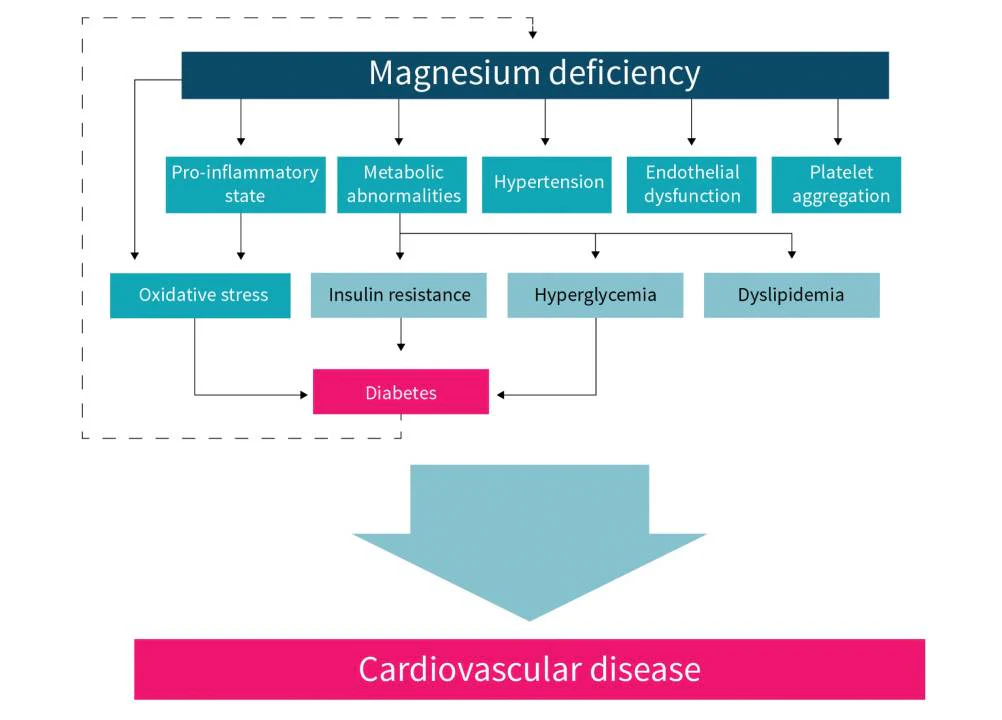
Adapted from Bo and Pisu. Curr Opin Lipidol. 2008.[52]
Magnesium is a factor in blood sugar metabolism[53] and may also assist in regulating inflammation, thus improving insulin sensitivity.[54]
It has been estimated that in developed countries, hypomagnesemia (subnormal magnesium levels in the blood) affects less than 15% of healthy people but up to 50% of people with type 2 diabetes.[55] Low magnesium intake is common in the US, as seen below. This is important because patients with low magnesium levels and type 2 diabetes can end up in a vicious cycle, with low magnesium increasing insulin resistance, which in turn decreases magnesium levels.[53]
The good news is, supplementing with magnesium can improve insulin sensitivity and modestly reducefasting blood sugarlevels in people withhypomagnesemia.[56][57][58]
Magnesium can lower blood sugar and may have additive effects when taken with other supplements or pharmaceuticals that can lower blood sugar, such as antidiabetic drugs.
People with elevated blood sugar taking magnesium may see a reduction in fasting blood sugar of −0.82 to −0.2 mmol/L (−14.77 to −3.60 mg/dL) after 3 months of supplementation, with greater reductions more likely in those with lower starting magnesium levels.
Zinc
WHAT MAKES ZINC A PRIMARY OPTION
Zinc can aid in improving insulin sensitivity, especially in people with type 2 diabetes or prediabetes who have low zinc levels.
Zinc is an essential dietary mineral. Around one fifth of the world’s population is thought to be at risk for zinc deficiency, but low zinc intake is rarer in developed countries, in part due to higher meat consumption.[59][60]
Dietary zinc isn’t the only consideration when it comes to zinc status, however. People with type 2 diabetes or insulin resistance may be more likely to have low levels of zinc in their blood. This doesn’t seem to be explained by differences in intake; it’s more likely that the disease itself may reduce zinc levels.[61] A reduction of zinc levels due to insulin resistance may create a vicious cycle: Insulin resistance lowers zinc levels, and lower zinc levels worsen insulin resistance, due to the role zinc plays in blood sugar metabolism and insulin secretion.[62][63][64]
POSSIBLE BENEFITS OF ZINC SUPPLEMENTATION IN PEOPLE WITH TYPE 2 DIABETES
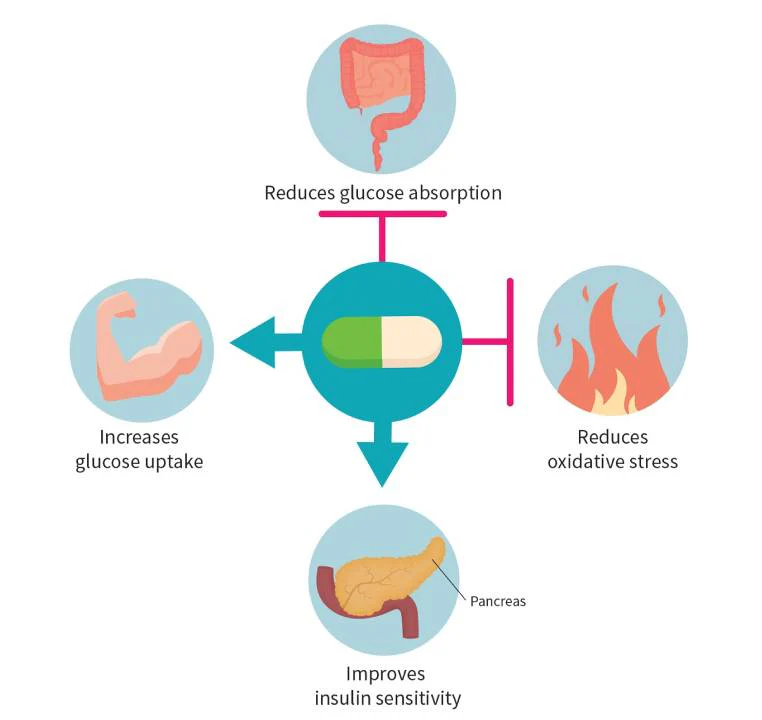
Reference: Ranasinghe et al. Daru. 2015.[63]
For people with type 2 diabetes or prediabetes, a zinc supplement can improve insulin sensitivity and thus lower levels offasting blood sugarandHbA1c(a measure of average glucose levels overthe past ≈3 months).[65][66][67][68][69][70][71][72][73][74][75] It’s not known if maintaining adequate zinc intake preserves insulin sensitivity or prevents type 2 diabetes in healthy, nonobese people. There are barely any trials that can assess prevention, and these trials aren’t nearly long enough to do so, though we can’t yet rule out the possibility.[76][77][78] However, in people who are overweight or obese and insulin resistant but not prediabetic or diabetic, zinc supplementation may reduce insulin resistance. The evidence for this isn’t as strong as for people with type 2 diabetes, though, and the effects are not nearly as pronounced.[79]
Zinc can lower blood sugar and may have additive effects when taken with other supplements or pharmaceuticals that can lower blood sugar, such as antidiabetic drugs
In people on the lower end of the normal range (12.9–16.7 µmoI/L, 84–109 mcg/dL) with:
normal blood sugars and no insulin resistance: take 5–10 mg/day of elemental zinc for maintenance
elevated blood sugars or insulin resistance: take 20 mg/day of elemental zinc
The Recommended Dietary Allowance (RDA) for zinc for adults ranges from 8–12 mg/day.[80] While the 20–40 mg/day doses discussed here exceed that, they do not exceed zinc’s Tolerable Upper Intake Level (UL) of 40 mg/day.[80]
Zinc sulfate and gluconate are the most researched forms of oral supplementation and are preferred. Zinc citrate seems to have comparable absorption to gluconate, whereas zinc oxide is less well absorbed.[81] Zinc picolinate and bis-glycinate may have greater absorption rates than gluconate, but more research is needed.[82][83]
Zinc absorption can be reduced if consumed with foods rich in phytates — namely, grains, legumes, seeds, and nuts.[84][85] If you’re unable to take zinc on an empty stomach, the next best way is with some low phytate food.
People with type 2 diabetes, prediabetes, or insulin resistance taking zinc may see a reduction in fasting blood sugar of −1.27 to −0.16 mmol/L (−22.88 to −2.88 mg/dL) and in HbA1c of −1.56 to −0.06%. Greater effects are more likely when baseline zinc levels are lower.
EFFECT OF ZINC VS PLACEBO ON GLYCEMIC CONTROL IN PEOPLE WITH PREDIABETES
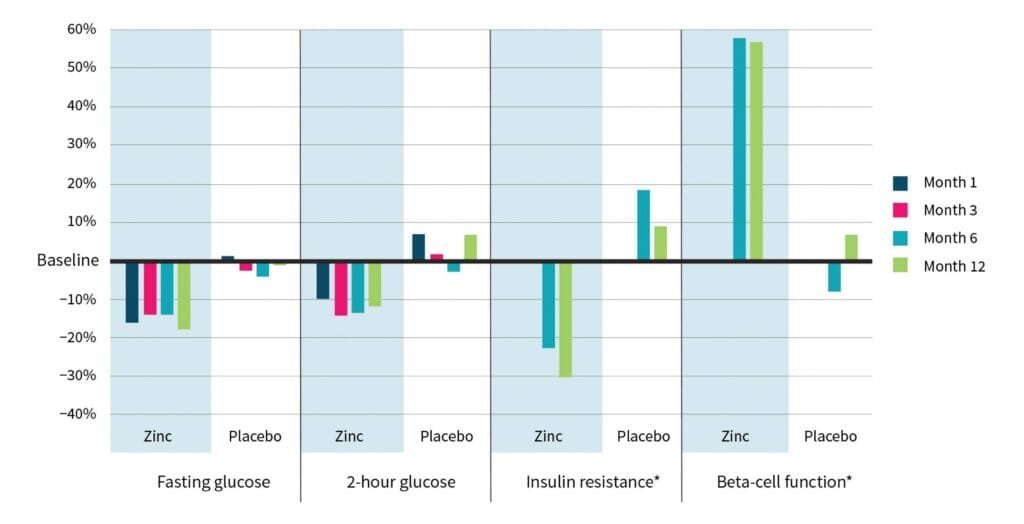
*Measures were only taken at months 6 and 12.
Reference: Ranasinghe et al. J Diabetes. 2018.[72]
Chromium
Chromium supplements may improve overall glycemic control in people with type 2 diabetes
Chromium is a trace element involved in insulin signaling to some degree, though just how remains a matter of debate.[86][87]T here is no standard and universally recognized measure of chromium status, but chromium levels in whole blood, blood plasma, toenails, and hair tend to be lower in people with type 1 or 2 diabetes than in people with normal blood sugar.[88][89][90][91][92][93][94] This is likely a result of increased chromium excretion (via urine, sweat, etc.) due to insulin resistance.[88]
Many randomized, controlled trials have evaluated chromium supplementation in type 2 diabetes. There’s solid evidence for modest reductions in fasting glucose and HbA1c but only limited evidence for improving fasting insulin and insulin resistance.[95] Studies are of moderate quality overall but inconsistent, with many finding a neutral effect and a few indicating a worsening in the chromium group.[96][97][98] It’s not clear why studies differ, though the severity of diabetes and baseline chromium levels are possible reasons. Research in females with polycystic ovary syndrome (PCOS) suggests a possible reduction in fasting glucose, insulin, and insulin resistance, but more research is needed to confirm this.[99][100][101]
Some supplements and multivitamins may “superdose” their product with chromium. Though chromium picolinate is generally considered nontoxic, chromium toxicity is not unheard of.[80]
The dosages listed in this guide may lower blood sugar and may have additive effects when taken with other supplements or pharmaceuticals that lower blood sugar, such as antidiabetic drugs.
People with type 2 diabetes taking Chromium picolinate may see a reduction in fasting blood sugar of -2.03 to -0.07 mmol/L (-36.58 to -1.26mg/DL) and a reduction in HbA1c of -1.13 to -0.22%
While other forms of chromium have been tested, such as brewer’s yeast and chromium chloride, studies to data have not indicated notable or reliable benefits to blood sugar management.
Saponins
Several repots have revealed that the hypoglycemic activity of most antidiabetic medical plants has been attributed to the presence of Saponins[102][103][104][105][106][107][108][109][110]. Ability of Saponins to reduce elevated plasma blood glucose makes Saponin an excellent candidate in the treatment of diabetes mellitus. The hypoglycemic action of Saponin is through: (a) Restoration of insulin response[111][112] , improvement in insulin signaling.[113] , (b) Increase plasma insulin levels and induction of insulin release from the pancreas.[114] , (c) Inhibition of disaccharide activity [115][116][117] (d) Activation of glycogen synthesis[118]. Saponins having potential therapeutic benefits and are theorized as an alternative medication in decreasing serum blood glucose in the patient suffering from diabetes.[119]
SCIENTIFIC LINKS
- Wasserman DH. Four grams of glucose.Am J Physiol Endocrinol Metab. (2009)
- De Meyts P. The Insulin Receptor and Its Signal Transduction Network.
- Mouri MI, Badireddy M. Hyperglycemia.
- Yuan T, et al. New insights into oxidative stress and inflammation during diabetes mellitus-accelerated atherosclerosis. Redox Biol. (2019)
- Lee SC, Chan JC. Evidence for DNA damage as a biological link between diabetes and cancer. Chin Med J (Engl). (2015)
- Hamed SA. Brain injury with diabetes mellitus: evidence, mechanisms and treatment implications. Expert Rev Clin Pharmacol. (2017)
- Einarson TR, et al. Prevalence of cardiovascular disease in type 2 diabetes: asystematic literature review of scientific evidence from across the world in 2007-2017. Cardiovasc Diabetol. (2018)
- Zhang J, et al. An updated meta-analysis of cohort studies: Diabetes and risk of Alzheimer’s disease. Diabetes Res Clin Pract. (2017)
- Yue X, et al. Risk of Parkinson Disease in Diabetes Mellitus: An Updated Meta-Analysis of Population-Based Cohort Studies. Medicine (Baltimore). (2016)
- Tsilidis KK, et al. Type 2 diabetes and cancer: umbrella review of meta-analyses of observational studies. BMJ. (2015)
- a b Magliano DJ, et al. Trends in incidence of total or type 2 diabetes: systematic review. BMJ. (2019)
- CDC. Diabetes Statistic Report. Centers for Disease Control and Prevention.
- Huang D, et al. Macrovascular Complications in Patients with Diabetes and Prediabetes. Biomed Res Int. (2017)
- Gummesson A, et al. Effect of weight reduction on glycated haemoglobin in weight loss trials in patients with type 2 diabetes. Diabetes Obes Metab. (2017)
- Franz MJ, et al. Lifestyle weight-loss intervention outcomes in overweight and obese adults with type 2 diabetes: a systematic review and meta-analysis of randomized clinical trials. J Acad Nutr Diet. (2015)
- Aune D, et al. Physical activity and the risk of type 2 diabetes: a systematic review and dose-response meta-analysis. Eur J Epidemiol. (2015)
- Liubaoerjijin Y, et al. Effect of aerobic exercise intensity on glycemic control in type 2 diabetes: a meta-analysis of head-to-head randomized trials. Acta Diabetol. (2016)
- Pan B, et al. Exercise training modalities in patients with type 2 diabetes mellitus: asystematic review and network meta-analysis. Int J Behav Nutr Phys Act. (2018)
- American Diabetes Association. Diabetes Care.
- Ollerton RL, et al. Day-to-day variability of fasting plasma glucose in newly diagnosed type 2 diabetic subjects. Diabetes Care. (1999)
- DeVries JH, et al. Day-to-day fasting self-monitored blood glucose variability is associated with risk of hypoglycaemia in insulin-treated patients with type 1 and type 2 diabetes: A post hoc analysis of the SWITCH Trials. Diabetes Obes Metab. (2019)
- a b Weickert MO, Pfeiffer AF. Metabolic effects of dietary fiber consumption and prevention of diabetes. J Nutr. (2008)
- a b Prasad KN, Bondy SC. Dietary Fibers and Their Fermented Short-Chain Fatty Acids in Prevention of Human Diseases. Mech Ageing Dev. (2018)
- Zhao L, et al. Gut bacteria selectively promoted by dietary fibers alleviate type 2 diabetes. Science. (2018)
- McNabney SM, Henagan TM. Short Chain Fatty Acids in the Colon and Peripheral Tissues: A Focus on Butyrate, Colon Cancer, Obesity and Insulin Resistance. Nutrients. (2017)
- Dreher ML. Introduction to Dietary Fiber. Dietary Fiber in Health and Disease. (2018)
- a b McRorie JW Jr. Evidence-Based Approach to Fiber Supplements and Clinically Meaningful Health Benefits, Part 1: What to Look for and How to Recommend an Effective Fiber Therapy. Nutr Today. (2015)
- a b Jovanovski E, et al. Should Viscous Fiber Supplements Be Considered in Diabetes Control? Results From a Systematic Review and Meta-analysis of Randomized Controlled Trials. Diabetes Care. (2019)
- McRae MP. Dietary Fiber Intake and Type 2 Diabetes Mellitus: An Umbrella Review of Meta-analyses. J Chiropr Med. (2018)
- Thompson SV, et al. Effects of isolated soluble fiber supplementation on body weight, glycemia, and insulinemia in adults with overweight and obesity: a systematic review and meta-analysis of randomized controlled trials. Am J Clin Nutr. (2017)
- Gibb RD, et al. Psyllium fiber improves glycemic control proportional to loss of glycemic control: a meta-analysis of data in euglycemic subjects, patients at risk of type 2 diabetes mellitus, and patients being treated for type 2 diabetes mellitus. Am J Clin Nutr. (2015)
- Dikeman CL, Fahey GC. Viscosity as related to dietary fiber: a review. Crit Rev Food Sci Nutr. (2006)
- a b c d Institute of Medicine et al.. Dietary Reference Intakes for Energy, Carbohydrate, Fiber, Fat, Fatty Acids, Cholesterol, Protein, and Amino Acids. The National Academies Press. (2005)
- a b Dreher ML. Fiber in Type 2 Diabetes Prevention and Management. Dietary Fiber in Health and Disease. (2017)
- Reynolds A, et al. Carbohydrate quality and human health: a series of systematic reviews and meta-analyses. Lancet. (2019)
- Dahl WJ, Stewart ML. Position of the Academy of Nutrition and Dietetics: Health Implications of Dietary Fiber. J Acad Nutr Diet. (2015)
- Gardner CD, et al. Effect of Low-Fat vs Low-Carbohydrate Diet on 12-Month Weight Loss in Overweight Adults and the Association With Genotype Pattern or Insulin Secretion: The DIETFITS Randomized Clinical Trial. JAMA. (2018)
- Slavin JL. Dietary fiber and body weight. Nutrition. (2005)
- Anderson JW, Konz EC, Jenkins DJ. Health advantages and disadvantages of weight-reducing diets: a computer analysis and critical review. J Am Coll Nutr. (2000)
- a b c Fernandez N, et al. Drug interactions with the dietary fiber Plantago ovatahusk. Expert Opin Drug Metab Toxicol. (2012)
- Fong SY, Gao Q, Zuo Z. Interaction of carbamazepine with herbs, dietary supplements, and food: a systematic review, Evid Based Complement Alternat Med. (2013)
- Wang H, et al. Metformin and berberine, two versatile drugs in treatment of common metabolic diseases. Oncotarget. (2017)
- a b c d Liang Y, et al. Effects of berberine on blood glucose in patients with type 2 diabetes mellitus: a systematic literature review and a meta-analysis. Endocr J. (2019)
- Wei W, et al. A clinical study on the short-term effect of berberine in comparison to metformin on the metabolic characteristics of women with polycystic ovary syndrome. Eur J Endocrinol. (2012)
- Yan HM, et al. Efficacy of Berberine in Patients with Non-Alcoholic Fatty Liver Disease. PLoS One. (2015)
- Pérez-Rubio KG, et al. Effect of berberine administration on metabolic syndrome, insulin sensitivity, and insulin secretion. Metab Syndr Relat Disord. (2013)
- Asemani S, et al. The Effects of Berberis Vulgaris Juice on Insulin Indices in Women with Benign Breast Disease: A Randomized Controlled Clinical Trial. Iran J Pharm Res. (2018)
- Lazavi F, et al. The barberry juice effects on metabolic factors and oxidative stress in patients with type 2 diabetes: A randomized clinical trial. Complement Ther Clin Pract. (2018)
- Moazezi Z, Qujeq D. Berberis Fruit Extract and Biochemical Parameters in Patients With Type II Diabetes. Jundishapur J Nat Pharm Prod. (2014)
- Shidfar F, et al. The Effects of Berberis vulgaris Fruit Extract on Serum Lipoproteins, apoB, apoA-I, Homocysteine, Glycemic Control and Total Antioxidant Capacity in Type 2 Diabetic Patients. Iran J Pharm Res. (2012)
- Dong H, et al. Berberine in the treatment of type 2 diabetes mellitus: a systemic review and meta-analysis. Evid Based Complement Alternat Med. (2012)
- Bo S, Pisu E. Role of dietary magnesium in cardiovascular disease prevention, insulin sensitivity and diabetes. Curr Opin Lipidol. (2008)
a b Gommers LM, et al. Hypomagnesemia in Type 2 Diabetes: A Vicious Circle?. Diabetes. (2016) - Mazidi M, Rezaie P, Banach M. Effect of magnesium supplements on serum C-reactive protein: a systematic review and meta-analysis. Arch Med Sci. (2018)
- Pham PC, et al. Hypomagnesemia in patients with type 2 diabetes. Clin J Am Soc Nephrol. (2007)
- Verma H, Garg R. Effect of magnesium supplementation on type 2 diabetes associated cardiovascular risk factors: a systematic review and meta-analysis. J Hum Nutr Diet. (2017)
- Simental-Mendía LE, et al. A systematic review and meta-analysis of randomized controlled trials on the effects of magnesium supplementation on insulin sensitivity and glucose control. Pharmacol Res. (2016)
- Veronese N, et al. Effect of magnesium supplementation on glucose metabolism in people with or at risk of diabetes: a systematic review and meta-analysis of double-blind randomized controlled trials. Eur J Clin Nutr. (2016)
- Wessells KR, Singh GM, Brown KH. Estimating the global prevalence of inadequate zinc intake from national food balance sheets: effects of methodological assumptions. PLoS One. (2012)
- Kumssa DB, et al. Dietary calcium and zinc deficiency risks are decreasing but remain prevalent. Sci Rep. (2015)
- a b Fernández-Cao JC, et al. Dietary zinc intake and whole blood zinc concentration in subjects with type 2 diabetes versus healthy subjects: A systematic review, meta-analysis and meta-regression. J Trace Elem Med Biol. (2018)
- Fukunaka A, Fujitani Y. Role of Zinc Homeostasis in the Pathogenesis of Diabetes and Obesity. Int J Mol Sci. (2018)
- a b Ranasinghe P, et al. Zinc and diabetes mellitus: understanding molecular mechanisms and clinical implications. Daru. (2015)
- Norouzi S, et al. Zinc transporters and insulin resistance: therapeutic implications for type 2 diabetes and metabolic disease. J Biomed Sci. (2017)
- Pérez A, et al. Zinc Supplementation Does Not Affect Glucagon Response to Intravenous Glucose and Insulin Infusion in Patients with Well-Controlled Type 2 Diabetes. Biol Trace Elem Res. (2018)
- Partida-Hernández G, et al. Effect of zinc replacement on lipids and lipoproteins in type 2-diabetic patients. Biomed Pharmacother. (2006)
- Seet RC, et al. Oral zinc supplementation does not improve oxidative stress or vascular function in patients with type 2 diabetes with normal zinc levels. Atherosclerosis. (2011)
- Al-Maroof RA, Al-Sharbatti SS. Serum zinc levels in diabetic patients and effect of zinc supplementation on glycemic control of type 2 diabetics. Saudi Med J. (2006)
- Gunasekara P, et al. Effects of zinc and multimineral vitamin supplementation on glycemic and lipid control in adult diabetes. Diabetes Metab Syndr Obes. (2011)
- Khan MI, et al. Effect of high-dose zinc supplementation with oral hypoglycemic agents on glycemic control and inflammation in type-2 diabetic nephropathy patients. J Nat Sci Biol Med. (2013)
- Islam MR, et al. Zinc supplementation for improving glucose handling in pre-diabetes: A double blind randomized placebo controlled pilot study. Diabetes Res Clin Pract. (2016)
- a b Ranasinghe P, et al. Zinc supplementation in prediabetes: A randomized double-blind placebo-controlled clinical trial. J Diabetes. (2018)
- Momen-Heravi M, et al. The effects of zinc supplementation on wound healing and metabolic status in patients with diabetic foot ulcer: A randomized, double-blind, placebo-controlled trial. Wound Repair Regen. (2017)
- Parham M, et al. Effect of zinc supplementation on microalbuminuria in patients with type 2 diabetes: a double blind, randomized, placebo-controlled, cross-over trial. Rev Diabet Stud. (2008)
- Afkhami-Ardekani M, et al. Effect of Zinc Sulfate Supplementation on Lipid and Glucose in Type 2 Diabetic Patients. Pakistan Journal of Nutrition. (2008)
- El Dib R, et al. Zinc supplementation for the prevention of type 2 diabetes mellitus in adults with insulin resistance. Cochrane Database Syst Rev. (2015)
- Roshanravan N, et al. Effect of zinc supplementation on insulin resistance, energy and macronutrients intakes in pregnant women with impaired glucose tolerance. Iran J Public Health. (2015)
- Lobene AJ, et al. Zinc Supplementation Does Not Alter Indicators of Insulin Secretion and Sensitivity in Black and White Female Adolescents. J Nutr. (2017)
- Cruz KJ, et al. The Effect of Zinc Supplementation on Insulin Resistance in Obese Subjects: a Systematic Review. Biol Trace Elem Res. (2017)
- a b c d e Institute of Medicine et al.. Dietary Reference Intakes for Vitamin A, Vitamin K, Arsenic, Boron, Chromium, Copper, Iodine, Iron, Manganese, Molybdenum, Nickel, Silicon, Vanadium, and Zinc. The National Academies Press. (2001)
- Wegmüller R, et al. Zinc absorption by young adults from supplemental zinc citrate is comparable with that from zinc gluconate and higher than from zinc oxide. J Nutr. (2014)
- Barrie SA, et al. Comparative absorption of zinc picolinate, zinc citrate and zinc gluconate in humans. Agents Actions. (1987)
- Gandia P, et al. A bioavailability study comparing two oral formulations containing zinc (Zn bis-glycinate vs. Zn gluconate) after a single administration to twelve healthy female volunteers. Int J Vitam Nutr Res. (2007)
- Bel-Serrat S, et al. Factors that affect zinc bioavailability and losses in adult and elderly populations. Nutr Rev. (2014)
- Schlemmer U, et al. Phytate in foods and significance for humans: food sources, intake, processing, bioavailability, protective role and analysis. Mol Nutr Food Res. (2009)
- Hua Y, et al. Molecular mechanisms of chromium in alleviating insulin resistance. J Nutr Biochem. (2012)
- Vincent JB. Is the Pharmacological Mode of Action of Chromium(III) as a Second Messenger?. Biol Trace Elem Res. (2015)
- a b Kaur B, Henry J. Micronutrient status in type 2 diabetes: a review. Adv Food Nutr Res. (2014)
- Ngala RA, Awe MA, Nsiah P. The effects of plasma chromium on lipid profile, glucose metabolism and cardiovascular risk in type 2 diabetes mellitus. A case-control study. PLoS One. (2018)
- Flores CR, et al. Trace elements status in diabetes mellitus type 2: possible role of the interaction between molybdenum and copper in the progress of typical complications. Diabetes Res Clin Pract. (2011)
- Gluschenko N, et al. THE CONTENT OF MICROELEMENTS IN BLOOD SERUM AND ERYTHROCYTES IN CHILDREN WITH DIABETES MELLITUS TYPE I DEPENDING ON LEVEL OF GLYCEMIC CONTROL. Georgian Med News. (2016)
- Kazi TG, et al. Copper, chromium, manganese, iron, nickel, and zinc levels in biological samples of diabetes mellitus patients. Biol Trace Elem Res. (2008)
- Chen S, et al. Inverse Association of Plasma Chromium Levels with Newly Diagnosed Type 2 Diabetes: A Case-Control Study. Nutrients. (2017)
- Zhou Q, et al. Comparison of Chromium and Iron Distribution in Serum and Urine among Healthy People and Prediabetes and Diabetes Patients. Biomed Res Int. (2019)
- Huang H, et al. Chromium supplementation for adjuvant treatment of type 2 diabetes mellitus: Results from a pooled analysis. Mol Nutr Food Res. (2018)
- Jain SK, et al. Effect of chromium dinicocysteinate supplementation on circulating levels of insulin, TNF-α, oxidative stress, and insulin resistance in type 2 diabetic subjects: randomized, double-blind, placebo-controlled study. Mol Nutr Food Res. (2012)
- Guimarães MM, Martins Silva Carvalho AC, Silva MS. Chromium nicotinate has no effect on insulin sensitivity, glycemic control, and lipid profile in subjects with type 2 diabetes. J Am Coll Nutr. (2013)
- Abraham AS, Brooks BA, Eylath U. The effects of chromium supplementation on serum glucose and lipids in patients with and without non-insulin-dependent diabetes. Metabolism. (1992)
- Fazelian S, et al. Chromium supplementation and polycystic ovary syndrome: A systematic review and meta-analysis. J Trace Elem Med Biol. (2017)
- Heshmati J, et al. The Effects of Supplementation with Chromium on Insulin Resistance Indices in Women with Polycystic Ovarian Syndrome: A Systematic Review and Meta-Analysis of Randomized Clinical Trials. Horm Metab Res. (2018)
- Tang XL, Sun Z, Gong L. Chromium supplementation in women with polycystic ovary syndrome: Systematic review and meta-analysis. J Obstet Gynaecol Res. (2018)
- G. Khanna, K. Kannabiran. Antimicrobial activity of saponin fractions of the leaves of Gymnema sylvestre and Eclipta prostrata. World J. Microbiol. Biotechnol., 24 (2008), pp. 2737-2740
- R. Petit, Y. Sauvaire, G. Ponsin, M. Manteghetti, A. Fave, G. Ribes. Effects of a fenugreek seed extract on feeding behaviour in the rat: metabolic endocrine correlates. Pharmacol. Biochem. Behav., 45 (1993), pp. 369-374
- J. Kim, Y.Y. Kim, K.H. Ko, E.K. Hong, Y.B. Han, B.H. Kang, H. Kim. Butanol extract of 1:1 mixture of Phellodendron cortex and Aralia cortex stimulates PI3-kinase and ERK2 with increase of glycogen levels in HepG2 cells. Phytother. Res., 12 (1998), pp. 255-260
- T. Lee, I.C. Sohn, D.H. Kim, J.W. Choi, S.H. Kwon Hypoglycaemic and hypolipidemic effects of tectorigenin and kaika-saponin III in the streptozotocin-induced diabetic rat and their antioxidant activity in vitro. Arch. Pharm. Res., 23 (2000), pp. 461-466
- Yoshikawa, T. Murakami, A. Kishi, T. Kageura, H. Matsuda Medicinal flowers.III. Marigold (1): hypoglycaemic, gastric emptying inhibitory, and gastroprotective principles and new oleanane-type triterpeneoligoglycosides, calendasaponins A, B, C, and D, from Egyptian Calendula officinalis. Chem. Pharm. Bull., 49 (2001), pp. 863-870
- H. Eu, W.Y. Lim, S.H. Ton, K.A. KadirGlycyrrhizic acid improved lipoprotein lipase expression, insulin sensitivity, serum lipid and lipid deposition in high – fat diet induced obese rats. Lipids Health Dis., 9 (2010), pp. 1-9
- T. Lee, T.W. Jung, H.J. Lee, S.G. Kim, Y.S. Shin, W.K. Whang.The antidiabetic effect of genosenoside Rb2 via activation of AMPK. Arch. Pharm. Res., 34 (2011), pp. 1201-1208
- K. Bhavsar, S. Singh, S. Giri, M.R. Jain, D.D. Santani.Effect of saponins from Helicteresisora on lipid and glucose metabolism regulating genes expression. J. Ethnopharmacol., 124 (2009), pp. 426-433
- X. Hu, Z. Li, Y. Xue, J. Xu, C. Xue, J. Wang, Y. Wang.Dietary saponins of sea cucumber ameliorate obesity, hepatic steatosis, and glucose intolerance in high-fat diet – fed mice
- Zheng, G. Shu, Z. Yang, S. Mo, Y. Zhao, Z. Mei.Antidiabetic effect of total saponins from Entada phaseoloides (L.) Merr. in type 2 diabetic rats
- O. Elekofehinti, J.P. Kamdem, I.J. Kade, J.B.T. Rocha, I.G. Adanlawo.Hypoglycemic, antiperoxidative and antihyperlipidemic effects of saponins from Solanum anguivi Lam. fruits in alloxan-induced diabetic rats. S. Afr. J. Bot., 88 (2013), pp. 56-61
- Y. Kwon, Y.S. Kim, Y.S. Ryu, Y.H. Choi, M.R. Cha, H.J. Yang, S. Park.Platyconic acid, a saponin from Platycodi radix, improves glucose homeostasis by enhancing insulin sensitivity in vitro and in vivo. Eur. J. Nutr., 51 (2012), pp. 529-540
- S. Metwally, A.M. Mohamed, F.S. ELSharabasy.Chemical constituents of the Egyptian Plant Anabasis articulata (Forssk) Moq and its antidiabetic effects on rats with streptozotocin-induced diabetic hepatopathy. J. Appl. Pharm. Sci., 2 (2012), pp. 54-65
- Marie, M.C. Anuff-Harding, F. Omoruyi.Intestinal disaccharides and some renal enzymes in streptozotocin-induced diabetic rats fed sapogenin extract from bitter yam. Life Sci., 78 (2006), pp. 2595-2600
- Mirunalini, R. Shahira.Novel effect of diosgenin – a plant derived steroid. A review Pharmacologyonline, 1 (2011), pp. 726-736
D. Habicht, V. Kind, S. Rudloff, C. Borsch, A.S. Mueller, J. Pallauf, R. Yang, M.B. KrawinkeQuantification of antidiabetic extracts and compounds in bitter gourd varieties. Food Chem., 126 (2011), pp. 172-176 - Y. Kim, H. Xiao, Y. Tan, Z.Z. Wang, S.J. Paul, X. Qu.The effects and mechanism of saponins of Panax notoginseng on glucose metabolism in 3T3-L1 Cells. Am. J. Chin. Med., 37 (2009), pp. 1179-1189
- Choudhary N, Khatik GL, Suttee A.The Possible Role of Saponin in Type-II Diabetes- A Review. Curr Diabetes Rev. 2021;17(2):107-121. doi: 10.2174/1573399816666200516173829. PMID: 32416696.
Safe And Scientific
Scientifically proven ingredients
Not just claims. Scientifically proven and evidence based ingredients
Team you can trust
Products developed by a team of Nutritionists, doctors, Exercise specialists and Scientists
Take home the science
we are the first company in India giving a printed material with scientific evidence
Guide to Fit and Healthy Lifestyle
Your true partner in health & wellness
